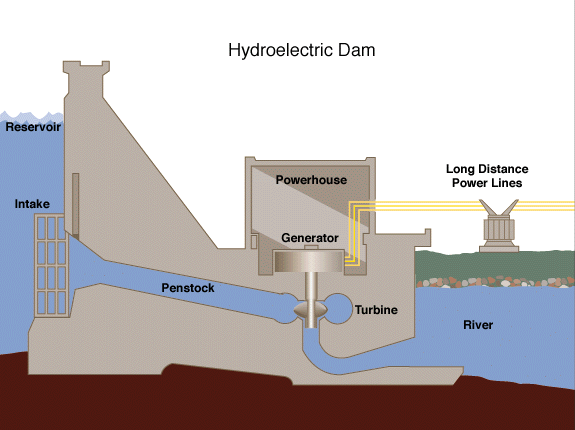Pumps are hydraulic machines that impart energy to fluids. Basically pumps are used to increase the pressure of fluid so that it can be raised to higher levels. There is a common misunderstanding that pumps increase fluid speed. Actually fluid pressure is increased primarily, not speed. Nowadays, pumps are seen in almost all industries and in all homes.
BASIC PRINCIPLE:
The basic principle of all pumps is that some energy is imparted to the fluid (usually by a rotating shaft or moving piston) which increases the pressure of fluid. As fluid pressure increases, the height to which a fluid can rise also increases.
There are many types of pumps such as positive displacement pumps, dynamic pumps, jet pumps etc… They all differ in the method of imparting energy to fluid. The basic principle in all cases remains the same. Here we are going to see how some of these pumps actually work.
TYPES OF PUMPS:
1. POSITIVE DISPLACEMENT PUMPS:
Positive displacement pumps maintain a constant flow of fluid. In these pumps fluid is drawn into an enclosed volume. This volume is then shrunk so that the fluid is forced out. Different positive displacement pumps exist. Each one differs in the methods the volume is squeezed. Best example of positive displacement pump is our heart. As the heart expands, bold is drawn in. then the muscles of the heart contract, thus decreasing its volume and thereby pumping out blood. Common examples of positive displacement pumps include rotary pump, gear pump, reciprocating pump etc…
1. A. ROTARY PUMP:
CONSTRUCTION AND WORKING:
A typical rotary pump consists of two lobes (as shown in video) rotating in opposite direction. The lobes are
shaped such that they fit closely and rotate smoothly as a pair. This rotary motion of the lobes creates a pressure difference which causes fluid to be sucked from left end of pipe. It is then discharged on to the other side. So these pumps maintain a flow continuously. There is a chance for the fluid to leak through the gap between the lobes, but this is less in the case of highly viscous fluids such as oil. So these pumps are primarily used as oil pumps in automobiles.
1. b. RECIPROCATING PUMP:
Main parts of a reciprocating pump:
a) Suction pipe: this is the pipeline through which water is drawn into the pump.
b) Delivery pipe: this is the pipe through which pressurized water is discharged from the pump.
c) Suction valve: this is a non return valve (a valve that allows fluid flow in one direction only) fitted inside the suction pipe.
d) Delivery valve: this is similar to that of suction valve and is fitted inside the delivery pipe.
e) Piston and cylinder: there is a cylinder with a closely fitted piston. The piston reciprocates within the cylinder.
f) Crank and connecting rod: a crank is provided which rotates continuously. The connecting rod converts the rotary motion of crank to the reciprocating motion of the piston.
WORKING OF RECIPROCATING PUMP:
An electric motor whose shaft is coupled with the crank provides to input power to drive the pump. As the crank rotates the piston reciprocates inside the cylinder. As the piston moves from the left end to the right end, a partial vacuum is created within the cylinder. This causes a decrease in pressure inside the cylinder (pressure decreases below atmospheric pressure). Also the decreased pressure forces the suction valve to open. Since water at the end of suction pipe is at atmospheric pressure, water moves to the region of low pressure. It rises through the suction pipe and enters the cylinder. After the cylinder becomes full, the suction valve closes. Delivery valve is also in closed condition now.
As the piston moves from right end to the left end, the water inside the cylinder is compressed by the piston. Due to this the pressure of water rises. When this water pressure reaches a certain high value, the delivery valve opens. Water flows out from the cylinder through the delivery pipe and is discharged out. Thus one cycle is completed. Now again as the piston moves back towards the right end, the process is repeated. The video given alongside will give a better understanding of reciprocating pumps.
Reciprocating pumps create very high pressure rise, but their discharge is low. Hence these pumps are used for high head, low discharge applications. Moreover if there is any blockage inside the delivery pipe the pressure inside the cylinder may raise drastically, which may damage the electric motor. So, proper safety measures should be taken. Moreover these pumps cannot pump water containing debris as it may cause blockage of pipes and damage the pump. Hence the uses of reciprocating pumps are limited to certain areas only.
2. DYNAMIC PUMPS:
Dynamic pumps usually consist of a rotating part called impeller or rotor. The impeller imparts energy to the fluid. The impeller rotates at a high-speed and this energy of impeller is gained by the fluid surrounding it. These pumps are also called roto-dynamic pumps. A common pump in this category is the centrifugal pump which is seen in households as well as in industries.
CENTRIFUGAL PUMP- CONSTRUCTION AND ITS WORKING:
A simple centrifugal pump consists of a scroll casing (which looks almost like a snail’s shell) and an
impeller. The impeller is connected to the shaft of an electric motor. Blades fitted on the impeller. The central region of impeller is called the eye of the impeller. Fluid enters axially from the eye via a suction pipe. The fluid particles then move along the passage between the blades. The impeller blades transfer energy to the fluid particles. The speed of fluid increases. The fluid is then thrown out from the blade tips into the scroll casing by the action of centrifugal force. The process is somewhat similar to the flying of a stone rotated by means of a string tied to it. When the string is released the stone follows a tangential path due to centrifugal force. At this instant, the fluid has more kinetic energy than pressure energy.
The characteristic feature of the scroll casing of the pump is that their area of cross-section gradually increases. So as a fluid flows inside the casing. Its velocity decreases and pressure increases based on continuity equation.
Continuity Equation:
Continuity equation is one of the fundamental equations in fluid mechanics. Consider it this in this way. In a closed system, such as a pipe or a casing (as in this case), the amount of fluid entering should be same as the amount of fluid leaving.
Mass flow in = Mass flow out.
min = mout
ℓ1A1V1 = ℓ2A2V2
Where ℓ is the fluid density, A is the area of cross-section and V is the velocity. The subscript 1 and 2 denote inlet and outlet respectively.
For an incompressible fluid, density remains the same for all cases. Hence the equation reduces to
A1V1 = A2V2
Thus, AV = a constant. So if area (A) increase, then the velocity (V) should decrease.
Here, in the case of centrifugal pump casing, as water
(or any other fluid) moves through the casing its area goes on increasing and therefore its velocity goes on decreasing. This decrease in velocity transforms as an increase of fluid pressure. Water is then discharged with significant pressure from the pump outlet. As a reminder of what we have said already at the beginning, the speed of fluid may not necessarily increase. But the fluid pressure definitely increases. The video clearly shows how the fluid moves inside the pump.
Centrifugal pumps are the most commonly used pumps. They can handle large volume of water and can even pump muddy water or pulp without any complications unlike reciprocating pumps. The pressure rise ( head rise) is small compared to that of reciprocating pumps, but still their ability to produce a large discharge makes them much more usable than reciprocating pumps.
A number of other pumps are also there such as jet pump, gear pump, vane pump. Each of these pumps are used in various field conditions.







